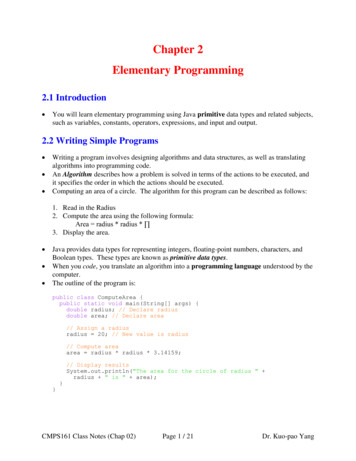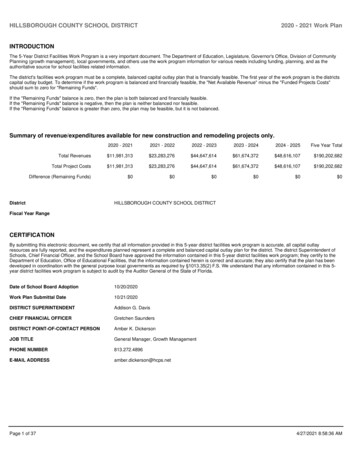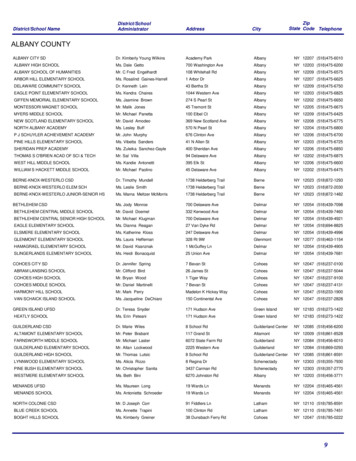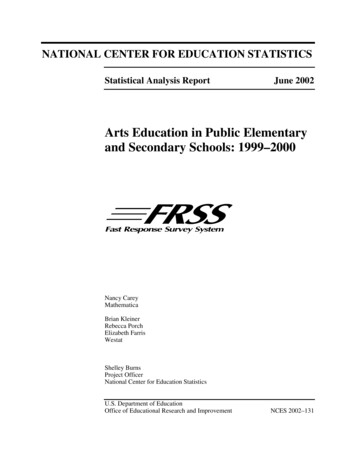
Transcription
Chapter 2Elementary Programming2.1 Introduction You will learn elementary programming using Java primitive data types and related subjects,such as variables, constants, operators, expressions, and input and output.2.2 Writing Simple Programs Writing a program involves designing algorithms and data structures, as well as translatingalgorithms into programming code.An Algorithm describes how a problem is solved in terms of the actions to be executed, andit specifies the order in which the actions should be executed.Computing an area of a circle. The algorithm for this program can be described as follows:1. Read in the Radius2. Compute the area using the following formula:Area radius * radius * 3. Display the area. Java provides data types for representing integers, floating-point numbers, characters, andBoolean types. These types are known as primitive data types.When you code, you translate an algorithm into a programming language understood by thecomputer.The outline of the program is:public class ComputeArea {public static void main(String[] args) {double radius; // Declare radiusdouble area; // Declare area// Assign a radiusradius 20; // New value is radius// Compute areaarea radius * radius * 3.14159;// Display resultsSystem.out.println("The area for the circle of radius " radius " is " area);}}CMPS161 Class Notes (Chap 02)Page 1 / 21Dr. Kuo-pao Yang
The program needs to declare a symbol called a variable that will represent the radius.Variables are used to store data and computational results in the program.Use descriptive names rather than x and y. Use radius for radius, and area for area. Specifytheir data types to let the compiler know what radius and area are, indicating whether they areinteger, float, or something else.The program declares radius and area as double-precision variables. The reserved worddouble indicates that radius and area are double-precision floating-point values stored in thecomputer.For the time being, we will assign a fixed number to radius in the program. Then, we willcompute the area by assigning the expression radius * radius * 3.14159 to area.The program’s output is:The area for the circle of radius 20.0 is 1256.636A string constant should not cross lines in the source code. Use the concatenation operator( ) to overcome such problem.CMPS161 Class Notes (Chap 02)Page 2 / 21Dr. Kuo-pao Yang
2.3 Reading Input from the ConsoleGetting Input Using Scanner Create a Scanner objectScanner scanner new Scanner(System.in); Use the methods next( ), nextByte( ), nextShort( ), nextInt( ), nextLong( ), nextFloat( ),nextDouble( ), or nextBoolean( ) to obtain to a string, byte, short, int, long, float, double, orboolean value. For example,System.out.print("Enter a double value: ");Scanner scanner new Scanner(System.in);double d scanner.nextDouble( ); Listing 2.2 ComputeAreaWithConsoleInput.javaimport java.util.Scanner; // Scanner is in the java.util packagepublic class ComputeAreaWithConsoleInput {public static void main(String[] args) {// Create a Scanner objectScanner input new Scanner(System.in);// Prompt the user to enter a radiusSystem.out.print("Enter a number for radius: ");double radius input.nextDouble();// Compute areadouble area radius * radius * 3.14159;// Display resultSystem.out.println("The area for the circle of radius " radius " is " area);}}Enter a number for radius: 23The area for the circle of radius 23.0 is 1661.90111 CautionBy default a Scanner object reads a string separated by whitespaces (i.e. ‘ ‘, ‘\t’, ‘\f’, ‘\r’, and‘\n’).CMPS161 Class Notes (Chap 02)Page 3 / 21Dr. Kuo-pao Yang
2.4 Identifiers Programming languages use special symbols called identifiers to name such programmingentities as variables, constants, methods, classes, and packages.The following are the rules for naming identifiers:o An identifier is a sequence of characters that consist of letters, digits, underscores( ), and dollar signs ( ).o An identifier must start with a letter, an underscore ( ), or a dollar sign ( ). It cannotstart with a digit.o An identifier cannot be a reserved word. (See Appendix A, “Java Keywords,” for alist of reserved words).o An identifier cannot be true, false, or null.o An identifier can be of any length.For example:o Legal identifiers are for example: 2, ComputeArea, area, radius, andshowMessageDialog.o Illegal identifiers are for example: 2A, d 4.o Since Java is case-sensitive, X and x are different identifiers.CMPS161 Class Notes (Chap 02)Page 4 / 21Dr. Kuo-pao Yang
2.5 Variables Variables are used to store data in a program.You can write the code shown below to compute the area for different radius:// Compute the first arearadius 1.0;area radius*radius*3.14159;System.out.println("The area is “ area " for radius " radius);// Compute the second arearadius 2.0;area radius*radius*3.14159;System.out.println("The area is “ area " for radius " radius);Declaring Variables Variables are used for representing data of a certain type.To use a variable, you declare it by telling the compiler the name of the variable as well aswhat type of data it represents. This is called variable declaration.Declaring a variable tells the compiler to allocate appropriate memory space for the variablebased on its data type. The following are examples of variable declarations:int x;// Declare x to be an integer variable;double radius; // Declare radius to be a double variable;char a;// Declare a to be a character variable; If variables are of the same type, they can be declared together using short-hand form:Datatype var1, var2, , varn; variables are separated by commasDeclaring and Initializing Variables in One Step You can declare a variable and initialize it in one step.int x 1;This is equivalent to the next two statements:int x;x 1;// shorthand form to declare and initialize vars of same typeint i 1, j 2; Tip: A variable must be declared before it can be assigned a value.CMPS161 Class Notes (Chap 02)Page 5 / 21Dr. Kuo-pao Yang
2.6 Assignment Statements and Assignments Expressions After a variable is declared, you can assign a value to it by using an assignment statement.The syntax for assignment statement is:variable expression;x 1;//radius 1.0;//a 'A';//x 5 * (3 / 2) 3 * 2; //x y 1;// // the result of x 1 is assigned to x;To assign a value to a variable, the variable name must be on the left of the assignmentoperator.1 x; 1 to x; Thus 1 x is wrong1.0 to radius;'A' to a;the value of the expression to x;the addition of y and 1 to x;The variable can also be used in the expression.x x 1; AssignAssignAssignAssignAssign// would be wrongIn Java, an assignment statement can also be treated as an expression that evaluates to thevalue being assigned to the variable on the left-hand side of the assignment operator. For thisreason, an assignment statement is also known as an assignment expression, and the symbol is referred to as the assignment operator.System.out.println(x 1);which is equivalent tox 1;System.out.println(x);The following statment is also correct:i j k 1;which is equivalent tok 1; j k; i j;CMPS161 Class Notes (Chap 02)Page 6 / 21Dr. Kuo-pao Yang
2.7 Named Constants The value of a variable may change during the execution of the program, but a constantrepresents permanent data that never change.The syntax for declaring a constant:final datatype CONSTANTNAME VALUE;final double PI 3.14159; // Declare a constantfinal int SIZE 3; A constant must be declared and initialized before it can be used. You cannot change aconstant’s value once it is declared. By convention, constants are named in uppercase.import java.util.Scanner; // Scanner is in the java.util packagepublic class ComputeAreaWithConstant {public static void main(String[] args) {final double PI 3.14159; // Declare a constant// Create a Scanner objectScanner input new Scanner(System.in);// Prompt the user to enter a radiusSystem.out.print("Enter a number for radius: ");double radius input.nextDouble();// Compute areadouble area radius * radius * PI;// Display resultSystem.out.println("The area for the circle of radius " radius " is " area);}} Note: There are three benefits of using constants:o You don’t have to repeatedly type the same value.o The value can be changed in a single location.o The program is easy to read.CMPS161 Class Notes (Chap 02)Page 7 / 21Dr. Kuo-pao Yang
2.8 Naming Conventions Use lowercase for variables and methods. If a name consists of several words, concatenate allin one, use lowercase for the first word, and capitalize the first letter of each subsequentword in the name. Ex: showInputDialog.Choose meaningful and descriptive names. For example, the variables radius and area, andthe method computeArea.Capitalize the first letter of each word in the class name. For example, the class nameComputeArea.Capitalize all letters in constants. For example, the constant PI.Do not use class names that are already used in Java library. For example, the constants PIand MAX VALUE.CMPS161 Class Notes (Chap 02)Page 8 / 21Dr. Kuo-pao Yang
2.9 Numerical Data Types and Operations2.9.1 Numeric Types Every data type has a range of values. The compiler allocates memory space to store eachvariable or constant according to its data type.Java has six numeric types: four for integers and two for floating-point numbers.TABLE 2.1 Numeric Data TypesNameRangeStorage Sizebyte–27 to 27 – 1 (-128 to 127)8-bit signedshort–215 to 215 – 1 (-32768 to 32767)16-bit signedint–231 to 231 – 1 (-2147483648 to 2147483647)32-bit signedlong–263 to 263 – 1(i.e., -9223372036854775808 to 9223372036854775807)64-bit signedfloatNegative range:-3.4028235E 38 to -1.4E-45Positive range:1.4E-45 to 3.4028235E 3832-bit IEEE 754doubleNegative range:-1.7976931348623157E 308 to -4.9E-32464-bit IEEE 754Positive range:4.9E-324 to 1.7976931348623157E 3082.9.2 Reading Numbers from the KeyboardScanner input new Scanner(System.in);int value input.nextInt();TABLE 2.2 Methods for Scanner ObjectsMethodDescriptionnextByte()reads an integer of the byte type.nextShort()reads an integer of the short type.nextInt()reads an integer of the int type.nextLong()reads an integer of the long type.nextFloat()reads a number of the float type.nextDouble() reads a number of the double type.CMPS161 Class Notes (Chap 02)Page 9 / 21Dr. Kuo-pao Yang
2.9.3 Numerical OperatorsTABLE 2.3 Numeric Operators NameMeaningExampleResult Addition34 135-Subtraction34.0 – 0.133.9*Multiplication300 * 309000/Division1.0 / 2.00.5%Remainder20 % 325/25.0/2-5/2-5.0/2yieldsyieldsyieldsyieldsan integera double valuean integer valuea double value22.5-2-2.55 % 2-7 % 3-12 % 4-26 % -820 % -13yieldsyieldsyieldsyieldsyields1 (the remainder of the division.)-10-27Remainder is very useful in programming. For example, an even number % 2 is always 0and an odd number % 2 is always 1. So you can use this property to determine whether anumber is even or odd. Suppose today is Saturday and you and your friends are going to meetin 10 days. What day is in 10 days? You can find that day is Tuesday using the followingexpression:Saturday is the 6th day in a weekA week has 7 days(6 10) % 7 is 2The 2nd day in a week is TuesdayAfter 10 daysCMPS161 Class Notes (Chap 02)Page 10 / 21Dr. Kuo-pao Yang
The program in Listing 2.5 (DisplayTime.java) obtains minutes and remaining seconds froman amount of time in seconds. For example, 500 seconds contains 8 minutes and 20 seconds.import java.util.Scanner;public class DisplayTime {public static void main(String[] args) {Scanner input new Scanner(System.in);// Prompt the user for inputSystem.out.print("Enter an integer for seconds: ");int seconds input.nextInt();int minutes seconds / 60; // Find minutes in secondsint remainingSeconds seconds % 60; // Seconds remainingSystem.out.println(seconds " seconds is " minutes " minutes and " remainingSeconds " seconds");}}Enter an integer for seconds: 500500 seconds is 8 minutes and 20 seconds2.9.4 Exponent OperationsSystem.out.println(Math.pow(2, 3));// Displays 8.0System.out.println(Math.pow(4, 0.5));// Displays 2.0System.out.println(Math.pow(2.5, 2));// Displays 6.25System.out.println(Math.pow(2.5, -2));// Displays 0.16CMPS161 Class Notes (Chap 02)Page 11 / 21Dr. Kuo-pao Yang
2.10 Numeric Literals A literal is a constant value that appears directly in a program. For example, 34, 1,000,000,and 5.0 are literals in the following statements:int i 34;long l 1000000;double d 5.0;2.10.1 Integer Literals An integer literal can be assigned to an integer variable as long as it can fit into the variable.A compilation error would occur if the literal were too large for the variable to hold.For example, the statement byte b 1000 would cause a compilation error, because 1000cannot be stored in a variable of the byte type.An integer literal is assumed to be of the int type, whose value is between -231 (-2147483648)to 231–1 (2147483647).To denote an integer literal of the long type, append it with the letter L or l (lowercase L).For example, the following code display the decimal value 65535 for hexadecimal numberFFFF.System.out.println(0xFFFF);2.10.2 Floating-Point Literals Floating-point literals are written with a decimal point. By default, a floating-point literal istreated as a double type value.For example, 5.0 is considered a double value, not a float value.You can make a number a float by appending the letter f or F, and make a number a doubleby appending the letter d or D.For example, you can use 100.2f or 100.2F for a float number, and 100.2d or 100.2D for adouble number.The double type values are more accurate than float type values.System.out.println("1.0 / 3.0 is " 1.0 / 3.0);// displays 1.0 / 3.0 is 0.3333333333333333System.out.println("1.0F / 3.0F is " 1.0F / 3.0F);// displays 1.0F / 3.0F is 0.333333342.10.3 Scientific Notations Floating-point literals can also be specified in scientific notation; for example, 1.23456e 2,same as 1.23456e2, is equivalent to 123.456, and 1.23456e-2 is equivalent to 0.0123456. E(or e) represents an exponent and it can be either in lowercase or uppercase.CMPS161 Class Notes (Chap 02)Page 12 / 21Dr. Kuo-pao Yang
2.11 Evaluating Expressions and Operator Precedence For example, the arithmetic expression3 4 x 10( y 5)(a b c)4 9 x 9( )5xxycan be translated into a Java expression as:(3 4 * x)/5 – 10 * (y - 5)*(a b c)/x 9 *(4 / x (9 x)/y) Operators contained within pairs of parentheses are evaluated first.Parentheses can be nested, in which case the expression in the inner parentheses is evaluatedfirst.Multiplication, division, and remainder operators are applied next. Order of operation isapplied from left to right. Addition and subtraction are applied last.LISTING 2.6 FahrenheitToCelsius.javaimport java.util.Scanner;public class FahrenheitToCelsius {public static void main(String[] args) {Scanner input new Scanner(System.in);System.out.print("Enter a degree in Fahrenheit: ");double fahrenheit input.nextDouble();// Convert Fahrenheit to Celsiusdouble celsius (5.0 / 9) * (fahrenheit - 32);System.out.println("Fahrenheit " fahrenheit " is " celsius " in Celsius");}}Enter a degree in Fahrenheit: 100Fahrenheit 100.0 is 37.77777777777778 in CelsiusCMPS161 Class Notes (Chap 02)Page 13 / 21Dr. Kuo-pao Yang
2.12 Case Study: Displaying the Current Time Write a program that displays current time in GMT (Greenwich Mean Time) in the formathour:minute:second such as 1:45:19.The currentTimeMillis method in the System class returns the current time in millisecondssince the midnight, January 1, 1970 GMT. (1970 was the year when the Unix operatingsystem was formally introduced.) You can use this method to obtain the current time, andthen compute the current second, minute, and hour as follows.ElapsedtimeTimeUnix Epoch01-01-197000:00:00 GMTCurrent TimeSystem.currentTimeMills()FIGURE 2.2 The System.currentTimeMillis() return the number of milliseconds since the Unixepoch. Listing 2.7 ShowCurrentTime.javapublic class ShowCurrentTime {public static void main(String[] args) {// Obtain the total milliseconds since midnight, Jan 1, 1970long totalMilliseconds System.currentTimeMillis();// Obtain the total seconds since midnight, Jan 1, 1970long totalSeconds totalMilliseconds / 1000;// Compute the current second in the minute in the hourlong currentSecond totalSeconds % 60;// Obtain the total minuteslong totalMinutes totalSeconds / 60;// Compute the current minute in the hourlong currentMinute totalMinutes % 60;// Obtain the total hourslong totalHours totalMinutes / 60;// Compute the current hourlong currentHour totalHours % 24;// Display resultsSystem.out.println("Current time is " currentHour ":" currentMinute ":" currentSecond " GMT");}}Current time is 17:31:26 GMTCMPS161 Class Notes (Chap 02)Page 14 / 21Dr. Kuo-pao Yang
2.13 Augmented Assignment OperatorsTable 2.4 Augmented Assignment OperatorsCMPS161 Class Notes (Chap 02)Page 15 / 21Dr. Kuo-pao Yang
2.14 Increment and Decrement Operators There are two more shortcut operators for incrementing and decrementing a variable by 1.These two operators are , and --. They can be used in prefix or suffix notations.suffixx ; // Same as x x 1;prefix x; // Same as x x 1;suffixx––; // Same as x x - 1;prefix––x; // Same as x x - 1;Table 2.5 Increment and Decrement Operatorsint i 10;int newNum 10 * i ;Same effect asint i 10;int newNum 10 * ( i);Same effect asint newNum 10 * i;i i 1;i i 1;int newNum 10 * i;Ex:double x 1.0;double y 5.0;double z x-- ( y);After execution, y 6.0, z 7.0, and x 0.0; Using increment and decrement operators make expressions short; it also makes themcomplex and difficult to read.Avoid using these operators in expressions that modify multiple variables or the samevariable for multiple times such as this: int k i i.CMPS161 Class Notes (Chap 02)Page 16 / 21Dr. Kuo-pao Yang
2.15 Numeric Type Conversions Consider the following statements:byte i 100;long k i * 3 4;double d i * 3.1 k / 2;Are these statements correct? When performing a binary operation involving two operands of different types, Javaautomatically converts the operand based on the following rules:1.2.3.4. If one of the operands is double, the other is converted into double.Otherwise, if one of the operands is float, the other is converted into float.Otherwise, if one of the operands is long, the other is converted into long.Otherwise, both operands are converted into int.Thus the result of 1 / 2 is 0, and the result of 1.0 / 2 is 0.5.Type Casting is an operation that converts a value of one data type into a value of anotherdata type.Casting a variable of a type with a small range to variable with a larger range is known aswidening a type. Widening a type can be performed automatically without explicit casting.Casting a variable of a type with a large range to variable with a smaller range is known asnarrowing a type. Narrowing a type must be performed explicitly.Caution: Casting is necessary if you are assigning a value to a variable of a smaller typerange. A compilation error will occur if casting is not used in situations of this kind. Becareful when using casting. Lost information might lead to inaccurate results.float f (float) 10.1;int i (int) f;double d 4.5;int i (int)d;// d is not changedSystem.out.println("d " d " i " i); // answer is d 4.5 i 4Implicit castingdouble d 3;// type wideningExplicit castingint i (int)3.0; // type narrowingint i (int)3.9; // type narrowing (Fraction part is truncated)What is wrong?int i 1;byte b i;// Error because explicit casting is requiredCMPS161 Class Notes (Chap 02)Page 17 / 21Dr. Kuo-pao Yang
2.16 Software Development Process The software development life cycle is a multistage process that includes requirementsspecification, analysis, design, implementation, testing, deployment, and maintenance.FIGURE 2.3 At any stage of the software development life cycle, it may be necessary to goback to a previous stage to correct errors or deal with other issues that might prevent thesoftware from functioning as expected. Requirement Specification: A formal process that seeks to understand the problem anddocument in detail what the software system needs to do. This phase involves closeinteraction between users and designers. Most of the examples in this book are simple, andtheir requirements are clearly stated. In the real world, however, problems are not welldefined. You need to study a problem carefully to identify its requirements.System Analysis: Seeks to analyze the business process in terms of data flow, and to identifythe system’s input and output. Part of the analysis entails modeling the system’s behavior.The model is intended to capture the essential elements of the system and to define servicesto the system.System Design: The process of designing the system’s components. This phase involves theuse of many levels of abstraction to decompose the problem into manageable components,identify classes and interfaces, and establish relationships among the classes and interfaces.IPO: The essence of system analysis and design is input, process, and output.Implementation: The process of translating the system design into programs. Separateprograms are written for each component and put to work together. This phase requires theuse of a programming language like Java. The implementation involves coding, testing, anddebugging.Testing: Ensures that the code meets the requirements specification and weeds out bugs. Anindependent team of software engineers not involved in the design and implementation of theproject usually conducts such testing.Deployment: Deployment makes the project available for use. For a Java program, thismeans installing it on a desktop or on the Web.CMPS161 Class Notes (Chap 02)Page 18 / 21Dr. Kuo-pao Yang
Maintenance: Maintenance is concerned with changing and improving the product. Asoftware product must continue to perform and improve in a changing environment. Thisrequires periodic upgrades of the product to fix newly discovered bugs and incorporatechanges. This program lets the user enter the interest rate, number of years, and loan amount andcomputes monthly payment and total payment.monthlyPay ment loanAmount monthlyInt erestRate11 (1 monthlyInt erestRate ) numberOfYears 12LISTING 2.9 ComputeLoan.javaimport java.util.Scanner;public class ComputeLoan {public static void main(String[] args) {// Create a ScannerScanner input new Scanner(System.in);// Enter yearly interest rateSystem.out.print("Enter yearly interest rate, for example 8.25: ");double annualInterestRate input.nextDouble();// Obtain monthly interest ratedouble monthlyInterestRate annualInterestRate / 1200;// Enter number of yearsSystem.out.print("Enter number of years as an integer, for example 5: ");int numberOfYears input.nextInt();// Enter loan amountSystem.out.print("Enter loan amount, for example 120000.95: ");double loanAmount input.nextDouble();// Calculate paymentdouble monthlyPayment loanAmount * monthlyInterestRate / (1- 1 / Math.pow(1 monthlyInterestRate, numberOfYears * 12));double totalPayment monthlyPayment * numberOfYears * 12;// Display resultsSystem.out.println("The monthly payment is " (int)(monthlyPayment * 100) / 100.0);System.out.println("The total payment is " (int)(totalPayment * 100) / 100.0);}}Enter yearly interest rate, for example 8.25: 5.75Enter number of years as an integer, for example 5: 15Enter loan amount, for example 120000.95: 250000The monthly payment is 2076.02The total payment is 373684.53CMPS161 Class Notes (Chap 02)Page 19 / 21Dr. Kuo-pao Yang
2.17 Case Study: Counting Monetary Units This program lets the user enter the amount in decimal representing dollars and cents andoutput a report listing the monetary equivalent in single dollars, quarters, dimes, nickels, andpennies. Your program should report maximum number of dollars, then the maximumnumber of quarters, and so on, in this order.LISTING 2.10 ComputeChange.javaimport java.util.Scanner;public class ComputeChange {public static void main(String[] args) {// Create a ScannerScanner input new Scanner(System.in);// Receive the amountSystem.out.print("Enter an amount in double, for example 11.56: ");double amount input.nextDouble();int remainingAmount (int)(amount * 100);// Find the number of one dollarsint numberOfOneDollars remainingAmount / 100;remainingAmount remainingAmount % 100;// Find the number of quarters in the remaining amountint numberOfQuarters remainingAmount / 25;remainingAmount remainingAmount % 25;// Find the number of dimes in the remaining amountint numberOfDimes remainingAmount / 10;remainingAmount remainingAmount % 10;// Find the number of nickels in the remaining amountint numberOfNickels remainingAmount / 5;remainingAmount remainingAmount % 5;// Find the number of pennies in the remaining amountint numberOfPennies remainingAmount;// Display resultsString output "Your amount " amount " consists of \n" "\t" numberOfOneDollars " dollars\n" "\t" numberOfQuarters " quarters\n" "\t" numberOfDimes " dimes\n" "\t" numberOfNickels " nickels\n" "\t" numberOfPennies " pennies";System.out.println(output);}}Enter an amount in double, for example 11.56: 11.56ÏÏÏYour amount 11.56 consists ofÏÏÏ11 dollarsÏÏÏ2 quartersÏÏÏ0 dimesÏÏÏ1 nickelsÏÏÏ1 penniesCMPS161 Class Notes (Chap 02)Page 20 / 21Dr. Kuo-pao Yang
2.18 Common Errors and Pitfalls Common Error 1: Undeclared/Uninitialized Variables and Unused Variableso Java is case-sensitive, X and x are different identifiersdouble interestRate 0.05;double interest interestrate * 45;// error: cannot find symbol interestrate Common Error 2: Integer Overflowo Max 32 bit integer value is 2147483647int value 2147483647 1;// value will actually be -2147483648 Common Error 3: Round-off Errorso Calculations involving floating-point numbers are approximated because these numbersare not stored with complete accuracy. For example,o Integers are stored precisely. Therefore, calculations with integers yield a precise integerresult.System.out.println(1.0 - 0.1 - 0.1 - 0.1 - 0.1 - 0.1);// display 0.5000000000000001, not 0.5System.out.println(1.0 - 0.9);// display 0.09999999999999998, not 0.9 Common Error 4: Unintended Integer Divisionint number1 1;int number1 1;int number2 2;int number2 2;double average (number1 number2) / 2; double average (number1 number2) / (average);(a) Bad code: display 1 (b) Good code: display 1.5Common Pitfall 1: Redundant Input ObjectsScanner input1 new Scanner(System.in);System.out.print("Enter an integer: ");int v1 input1.nextInt();Scanner input2 new Scanner(System.in);System.out.print("Enter a double value: ");double v2 input2.nextDouble();Scanner input new Scanner(System.in);System.out.print("Enter an integer: ");int v1 input.nextInt();System.out.print("Enter a double value: ");double v2 input.nextDouble();(a) Bad code: two input objectsCMPS161 Class Notes (Chap 02)(b) Good code: one input objectPage 21 / 21Dr. Kuo-pao Yang
CMPS161 Class Notes (Chap 02) Page 1 / 21 Dr. Kuo-pao Yang Chapter 2 Elementary Programming 2.1 Introduction You will learn elementary programming using Java primitive data ty










